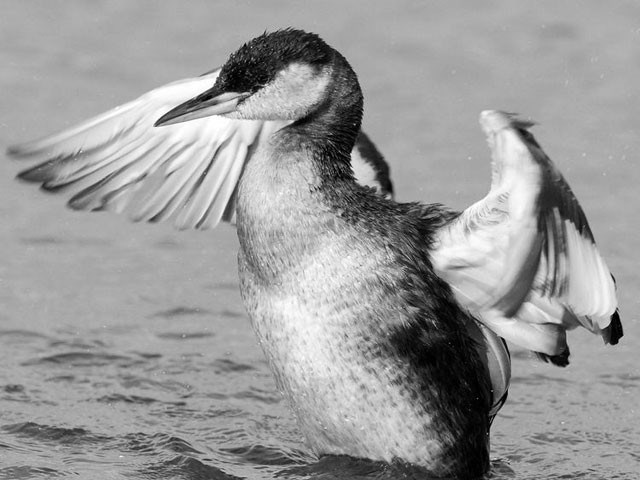There is no question, five species of grebes were the stars of this year’s autumn migratory season. Numbers on grebes had been low for many years and their return to historical levels was indeed a surprise.
On both Alta and Green Lakes, we had several days of 30 to 40 each of Horned and Western grebes, the latter with a long slender neck, which in distant or obscured views can be confused with Trumpeter swans.
There were also two to three Red-necked and Pied-billed grebes on the lakes for two months or longer, and for two days there was a much rarer (for this corridor) Eared grebe. As luck would bear out, all five species were seen on the same day, unusual to say the least.
As to be expected, waterfowl dominated the autumn parade with 37 species tallied. The Trumpeter swans were the last to arrive; the surprising no-shows were Blue-winged and Cinnamon teal while the Harlequin ducks disappeared in late summer.
Raptors were scarce throughout the season with only four species seen, but rarely. However, we nabbed the Northern Shrike on the Fitzsimmons Creek delta, a bird not seen every year.
Game and shore birds were also scarce, though Killdeer and Wilson’s snipe popped up on occasion. Spotted sandpipers were consistently present in their usual numbers, but other pipers eluded us entirely.
High water on Green Lake shifted the mud-probing Long-billed dowitchers to Rainbow Park where dogs continually harassed their presence along the beach front.
Gull counts have now returned to their historic low figures, though a large flock of 25-30 Bonaparte gulls on Green Lake was surprising. Normally, no more than three to four are seen at any one time, and infrequently at that.
Reports of hooting Barred and Great horned (but no other) owls were few. There were several blitzes of swifts both here and at Pemberton, with the Black swift being our first autumn record. Rufus hummingbirds also prolonged their stay well into October for no obvious reason.
Among our song birds the numbers of migratory robins, and Yellow-rumped warblers were especially high on many days, while Ruby-crowned Kinglets had high counts on a few days. Sparrows were at usual levels with no unusual species spotted. Red-winged blackbirds, however, dipped in sighting frequency and no large flocks were seen. Not unexpected were the total lack of all swallow and flycatcher species. As usual, finch species were elusive to find, although Evening grosbeaks of continent-wide concern were seen on a few days.
All told, 110 of the 185 species on the autumn checklist were tallied, netting a lower than normal 59 per cent recovery factor.
There were no new species added during the autumn to the Whistler checklist which stands at 250. November 30 is the end of the “fiscal” year for birding.
For the 2007 year, 191 species were recorded, netting a satisfactory 76 per cent recovery factor. Three species new to Whistler were added over the year to our list, and there were seasonal adjustments on at least 20 other species, indicating the complexity of movements in our birding populations, some of which are brought on by subtle changes in climate.
More surprises are bound to be in store for 2008, beginning with what turns up or fails to show on our Christmas bird census, tomorrow!




